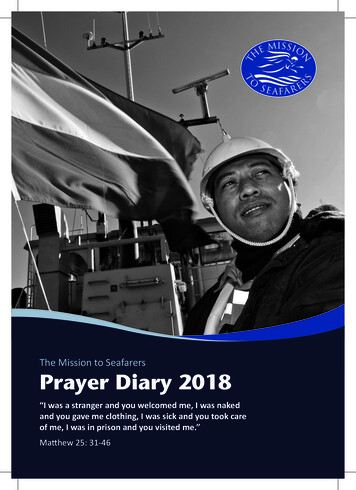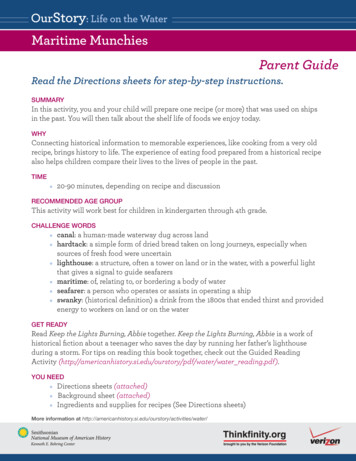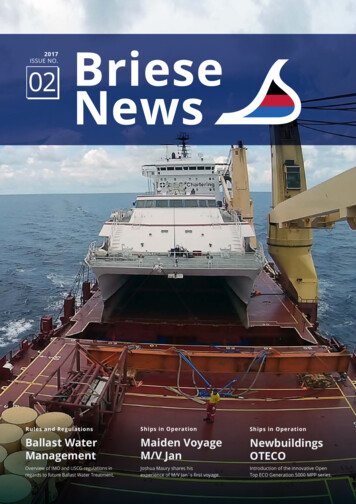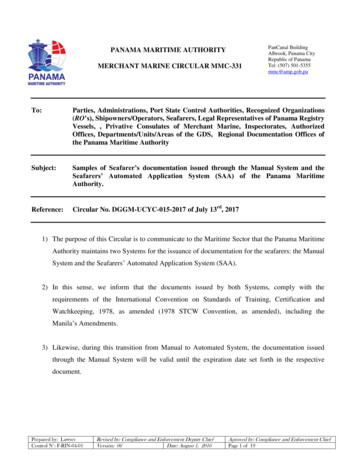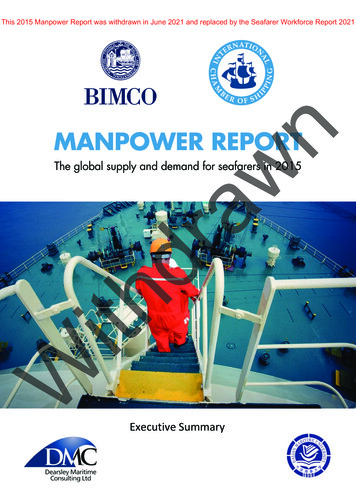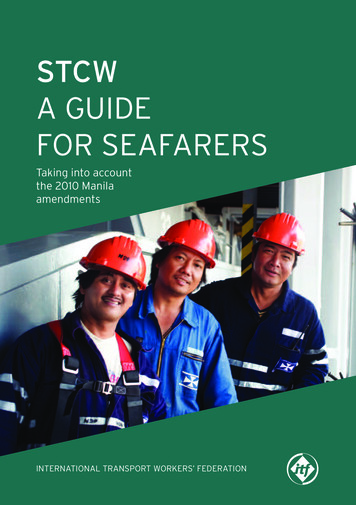
Transcription
STCWA GUIDEFOR SEAFARERSTaking into accountthe 2010 ManilaamendmentsINTERNATIONAL TRANSPORT WORKERS’ FEDERATION
INTERNATIONAL TRANSPORT WORKERS’ FEDERATIONForewordIn June 2010 a diplomatic conference in Manila adopted a set of far-reaching andcomprehensive amendments to the 1978 International Convention on Training,Certification and Watchkeeping for Seafarers – known to us all more conveniently asthe STCW Convention – and its associated Code. This instrument has been described asone for the four pillars of the global maritime regulatory system, along with two otherIMO Conventions, SOLAS and MARPOL, and ILO’s Maritime Labour Convention. Theamendments adopted mark the first major revision of the instrument since thoseadopted in 1995, which completely revised the original 1978 STCW Convention.The shipping industry depends on competent, well-trained seafarers to ensure safetyof life at sea, maritime security, efficiency of navigation and protection andpreservation of the marine environment. The revised STCW Convention aims toprovide the international standards necessary for training institutes and trainers todevelop the much-needed skills and competencies for today’s seafarer.The ITF has produced this guidance to help seafarers understand the revisions andlocate the information that is of most relevance to them. I support this effort to makethe Convention requirements accessible to all and trust that this guide will support theachievement of the objectives of the STCW Convention and Code.Koji SekimizuSecretary-General, IMOSTCW: A GUIDE FOR SEAFARERS3
INTERNATIONAL TRANSPORT WORKERS’ FEDERATIONContentsAbout this guide7Section 1:The STCW ConventionLayout of the conventionDeadlines to meetGlossary of termsAdditional definitions and requirements of the amended STCW Convention1112131416Section 2:Certification requirements17Part 1 — STCW certificatesCertificatesCertification pathsGeneral requirements for officersGeneral requirements for ratings18222426Part 2 — Certificates and general requirements by rankMasterChief mateOfficer in charge of a navigational watchRatings forming part of a navigational watchAble seafarer deckRadio operatorsChief engineerSecond engineerOfficer in charge of an engineering watchElectro-technical officerRatings forming part of an engineering watchAble seafarer engineElectro-technical ratingsAny other crew member2930313334353637383940414243Part 3 — Other certificatesFor personnel on any type of shipAdditional non mandatory trainingFor personnel on tankersFor personnel on passenger ships444647Part 4 — Training issuesEducation and training issuesSimulator training under STCWEnglish language requirements484949STCW: A GUIDE FOR SEAFARERS5
INTERNATIONAL TRANSPORT WORKERS’ FEDERATIONThe use of distance learning and e-learningOnboard training and assessmentResponsibilities of companiesImplementation of the ISM code relevant to STCWGMDSS (global maritime distress and safety system) certificatesMedical fitness standards494950505051Section 3:On board requirementsCertificates and documentary evidence to be carried on boardMandatory safety and ship-board familiarisation trainingOn-board training and assessmentSeagoing serviceAlcohol and drug consumptionControl provisionsPenaltiesRegulations affecting watch-keeping personnel duty545456585960616364Section 4:Implications of amendments to STCW holdersUpgrading and revalidationAdditional competence requirements under 2010 STCWMaster and deck departmentEngine department6768696970Section 5:Where to find more information on STCW74Annex AList of countries party to STCW75Annex BIMO circular (STCW.7/circ.17) on guidance for port statecontrol inspectors in respect of certificates of competenceissued under the provisions of the STCW Convention76Annex CSummary of requirements678STCW: A GUIDE FOR SEAFARERS
INTERNATIONAL TRANSPORT WORKERS’ FEDERATIONAbout this guideThis guide is aimed at seafarers of all ranks and nationalities. Its main purpose is tohelp you find out how the 2010 Manila amendments to the STCW will affect you.Although we have tried to make this guide as accurate as possible, you should contactthe maritime Administration issuing your certificate(s) of competency andendorsement(s) for specific information on the national requirements and deadlinesyou must meet.Section 1 gives background information on the amended STCW Convention, includingdeadlines to meet, and provides a brief glossary of terms.Section 2 outlines the certificates you need to hold before signing on a ship in orderto ensure that you comply with the amended STCW. This section consists of four parts.Part 1 tells you about STCW certificates, certification paths and general requirementsfor officers and ratings. Part 2 lists the certificates and general requirementsdemanded according to rank. Part 3 tells you what certificates you need, dependingon your function on board and the type of vessel you are working on. Part 4 givesguidance on training establishments, simulator requirements, English language andGMDSS certificates.Section 3 deals with the requirements you need to meet once you are on board.This includes what documentation you must have with you at all times, ship-specificfamiliarisation training, training records and sea-going service. It also covers theregulations on alcohol and drug consumption, control procedures and penalties.There is also a section applying to watch-keeping personnel only, officers and ratings,on rest hour regulations and watch-keeping guidelines.Section 4 tells you what you need to do to if you are a holder of an STCW-95certificate and need to update your certificate to 2010 amended STCW. This sectionincludes tables that summarise by rank the additional competencies you need todemonstrate to upgrade your certificate.Finally, Section 5 lists other sources of information you can consult should you wantto know more about the 2010 amended STCW.This guide is produced by the International Transport Workers’ Federation (ITF).You can also download a free version from our website at www.itfglobal.orgSTCW: A GUIDE FOR SEAFARERS7
INTERNATIONAL TRANSPORT WORKERS’ FEDERATION8STCW: A GUIDE FOR SEAFARERS
tionnevnoCTCWS:1noitSec
INTERNATIONAL TRANSPORT WORKERS’ FEDERATION10STCW: A GUIDE FOR SEAFARERS
INTERNATIONAL TRANSPORT WORKERS’ FEDERATIONThe STCW ConventionThe key to maintaining a safe shipping environment and keeping our oceans clean liesin all seafarers across the world observing high standards of competence andprofessionalism in the duties they perform on-board. The International Convention onStandards of Training, Certification and Watchkeeping for Seafarers 1978, as amendedin 1995 and again in 2010, sets those standards, governs the award of certificates andcontrols watchkeeping arrangements . Its provisions not only apply to seafarers, butalso to ship-owners, training establishments and national maritime administrations.The convention was adopted by the International Maritime Organization (IMO) in 1978and came into force in 1984. During the late 1980s, it was clear that STCW-78 was notachieving its aim of raising professional standards worldwide, and so IMO membersdecided to amend it. This was done in the early 1990s, and the amended conventionwas then called STCW-95.The 2010 Manila amendments was intended to include all agreed changes since 1995,address new technology, inconsistencies, interpretations and outdated provisions.There was particular emphasis on improving control and communication provisions ofcertification in Chapter 1 and addressing the specific requirements of offshore andshort sea shipping. There was also an overall commitment to harmonise the amendedSTCW Convention, where practical, with the provisions of the 2006 ILO MaritimeLabour ConventionWhereas the STCW-78 Convention focused almost entirely on knowledge, the emphasisof STCW-95 has been shifted to practical skills and competence underpinned bytheoretical knowledge. The 2010 amendments continued to emphasise competencerather than sea service or period of training. The standard set by the conventionapplies to seafarers of all ranks serving on sea-going merchant ships registered underthe flag of a country party to the convention.The term “seagoing ships” includes all commercial vessels engaged on domestic orinternational voyages. The STCW Convention does not apply to seafarers serving onwarships, naval auxiliaries or any other government owned or operated ship engagedin non-commercial service; fishing vessels (there is a separate convention coveringpersonnel on fishing vessels); pleasure yachts not engaged in trade and wooden shipsof primitive build.The STCW (95) Convention has already been accepted by all major labour suppliersand shipping registries. This is more than 98 per cent of the world’s merchant fleet.At the end of this guide you will find a list of all countries that are parties to thecurrent convention and the dates of acceptance but does not indicate those who areimplementing fully the 2010 amendments. Governments must submit reports on theircompliance to the IMO by 1 January 2013.STCW: A GUIDE FOR SEAFARERS11
INTERNATIONAL TRANSPORT WORKERS’ FEDERATIONLayout of the conventionThe STCW Convention is a book consisting of three sections.1. The articles: outline the legal responsibilities a party has to meet.2. The annex: gives technical details on how the legal responsibilities referred to in thearticles should be met.3. The STCW Code: specifies in more depth the technical details contained in theannex. It contains part A and part B.Part A:Mandatory standards of training, certification and watch-keeping.Part B:Recommended guidelines (not mandatory) on training, certification and watch-keeping.The regulations in the annex should be read in conjunction with the relevant sectionof the STCW Code (part A). It is a good idea to familiarise yourself with the convention.After all, the standards of competence that you are expected to meet are specifiedthere. A copy of the STCW Convention is normally kept on board all sea-goingmerchant ships.12STCW: A GUIDE FOR SEAFARERS
INTERNATIONAL TRANSPORT WORKERS’ FEDERATIONDeadlines to meetThe 2010-amended STCW Convention came into force on 1 January 2012. However,there is a five year transitional period, until 1 January 2017, to allow for a phased inimplementation of the provisions. After January 2017, all seafarers are required tomeet STCW 2010 standards. The three important dates to remember are:1 January 2012The STCW Convention comes into force for all countries party to the convention. From1 January 2012 onwards, requirements for the new minimum rest hours and a record ofhours of work must be complied with. For a period of five years, until 1 February 2017,on a national basis the different revised regulations contained in the 2010-amendedconvention will be phased in. During this five year transitional period, a party maycontinue to issue certificates of competency in accordance with its previous practices,however from 1 July 2013 new seafarers-training and competence should comply withthe 2010-amended STCW Convention.1 January 2014After 1 January 2014 seafarers will have to be trained in security in compliance withthe new provisions.1 January 2017The implementation period ends. From February 2017 onwards all seafarers onactive service must comply with all the 2010-amended STCW requirements and be inpossession of a valid STCW certificate covering the functions performed on-board.Administrations will also issue and recognise and endorse certificates in accordancewith the STCW provisions prior to 2010 for those commencing training prior to1 July 2013.STCW: A GUIDE FOR SEAFARERS13
INTERNATIONAL TRANSPORT WORKERS’ FEDERATIONGlossary of termsYou need to know the meaning of some basic terms that will be used in this guide:Administration:The government of the Party (country) whose flag a ship is entitled to fly. Anadministration deals, among other things, with regulating the training, education andcertification of seafarers in accordance with the requirements of the convention.Approved:This means that a national maritime administration has approved a trainingprogramme or seagoing service because it meets the requirements of the amendedSTCW Convention.Function:This is a way of classifying shipboard tasks by functions and levels of responsibility.There are seven functional areas, at three different levels of responsibility. The levelsof responsibility are: management level (applies to senior officers); operational level(applies to junior officers); and support level (applies to ratings forming part of anavigational or engine watch). The following table lists the different functions andlevels of responsibility at which the functions can be carried out.FUNCTIONLEVEL OF RESPONSIBILITYManagementDeckNavigationCargo handling and stowageDeck &EngineControlling the operationof a ship and care forpersons on boardEngineMarine engineeringMaintenance and repairElectrical, electronicsand control engineeringRadioRadio :A country where the STCW Convention has entered into force. A party is under theobligation to implement the standards contained in the convention.Seagoing service:Service on board a ship relevant to the issue of a certificate or other qualification. Forexample, one of the requirements to qualify as a rating forming part of a navigationalwatch is to have approved seagoing service, including not less than six months’training and experience.14STCW: A GUIDE FOR SEAFARERS
INTERNATIONAL TRANSPORT WORKERS’ FEDERATIONSeagoing ship:A ship navigating in areas not close to inland or sheltered waters or where portregulations apply.Standard of competence:This term refers to the minimum knowledge, understanding and proficiency thatseafarers must demonstrate to gain certification. The tables contained in part A of theSTCW Code specify the standards of competence to be achieved by the seafarer. Thethinking behind dividing all duties on board into competencies, functions, and levels ofresponsibility is that certificates should be awarded on the basis of the specific dutiesthe seafarer carries out on-board rather than on ship departmental divisions(deck/engine).For the complete tables and full details of standards of competence applying to thecertificates you hold, refer to the STCW Code (part A) in the 2010-amended STCWConvention.The 2010 amendments only refer to the following certifications:Certificate of competence:A certificate issued and endorsed by the administration, for masters, officer andGMDSS radio operators in accordance with the provisions of chapters II, III, IV or VIIand entitles the lawful holder thereof to serve in the capacity and perform thefunctions involved at the level of responsibility specified.Certificate of proficiency:A certificate, other than a certificate of competency issued to a seafarer, stating thatthe relevant requirements of training, competencies or seagoing service in theconvention have been met.Documentary evidence:Documentation, other than a certification of competency or certificate of proficiencyused to establish that the relevant requirements of the convention have been met.STCW: A GUIDE FOR SEAFARERS15
INTERNATIONAL TRANSPORT WORKERS’ FEDERATIONAdditional definitions and requirementsof the amended STCW ConventionShip security officer means the person on-board the ship, accountable to the master,designated by the company as responsible for the security of the ship, includingimplementation and maintenance of the ship security plan and liaison with thecompany security officer and port facility security officers;Note: the designation of a ship security officer is mandatory.Security duties include all tasks and duties on-board ships as defined by chapter XI-2of SOLAS and the ISPS code.Electro-technical officer means an officer qualified in accordance with the provisionsof regulation III/6 of the convention.Electro-technical rating means a rating qualified in accordance with the provisionsof regulation III/7 of the convention.Note: these positions are not a manning requirement or prohibit other positionsof other electrical roles onboardAble seafarer deck means a rating qualified in accordance with the provisions ofregulation II/5 of the convention.Able seafarer engine means a rating qualified with the provisions of regulation III/5of the convention.Note: The qualification for able seafarer, previously covered under ILO convention (74)has been transferred to the IMO. National administrations should make provisionfor the acceptance and endorsement of current holders of an AB certificate. TheAB seafarer engine is a new qualification and, under section A VII/2.3 and 4,there are new provisions for an integrated rating covering both deck and engineduties. These positions are not mandatory under the safe manning requirementsunless required by the administration.16STCW: A GUIDE FOR SEAFARERS
entsmeriuqeion rtacifitre:CSection 2
INTERNATIONAL TRANSPORT WORKERS’ FEDERATIONPART 1 — STCW certificatesCertificatesThe term ‘certificates’ covers all official documents required under STCW. It includescertificates of competence, endorsements, certificates of proficiency, and anydocumentary evidence showing that a requirement of the convention has been met.Certificates are important as they are the main paper evidence you have on hand toprove that your level of maritime education and training, your length of service at sea,your professional competence, medical fitness and age all comply with STCWstandards. Every party to the convention has to ensure that certificates are only issuedto those seafarers who meet STCW standards.Certificate of competence:This document is issued to masters, officers, radio operators and ratings forming partof a watch who meet the standards of competence relevant to their particularfunctions and level of responsibility on-board. The table below indicates the title of thecertificates under STCW and the various limitations and tonnage thresholds that apply.18CAPACITYAREA LIMITATIONTONNAGE LIMITATIONMasterNear CoastalNoneNoneLess than 500gtLess than 3,000 gtNoneChief MateNoneNoneLess than 3,000 gtNoneOfficer in chargeof navigational watch (OOW)Near coastalNoneLess than 500 gtNoneRating forming partof a navigational watchNoneNoneRadio operatorGMDSS (GOC/ROC)NoneCAPACITYAREA LIMITATIONPROPULSION POWERLIMITATIONChief engineerNoneNoneNear CoastalNear Coastal750 kw to 3,000 kw3,000kw or more750 kw to 3,000 kw3,000 kw or moreSecond engineerNoneNoneNear coastalNear Coastal750 kw to 3,000 kw3,000 kw or more750 kw to 3,000 kw3,000 kw or moreOfficer in chargeof engineering watch (OOW)NoneNear Coastal750 kw or moreLess than 3,000kwRating forming partof a engineering watchNoneNoneSTCW: A GUIDE FOR SEAFARERS
INTERNATIONAL TRANSPORT WORKERS’ FEDERATIONEndorsement:A document issued to masters and officers, either as part of the certificate or as aseparate document. This attests (endorses) that the national certificate has beenissued in accordance with all STCW requirements. However, due to the ongoingproblem with fraudulently issued certificates, the amended 2010 STCW Convention hasmade substantial changes in regulation I/2 to tighten up on the endorsement process.It is now required that all endorsements are only issued by the administration afterfully verifying the authenticity of any certificates and documentary evidence, and thecandidate has fulfilled all requirements and has the standard of competence for thecapacity identified in the endorsement. There is also a requirement to ensure there isproper approval of the equivalent seagoing service and training and also to maintaina database of certification registration with a controlled electronic access.Endorsement of recognition:This endorsement certificate is issued by an administration as an official recognitionof the validity of a certificate issued by another administration. This procedure isnecessary as many merchant fleets are manned by seafarers certificated by otheradministrations. In other words, if you hold a certificate from country ‘x’ , but you areserving on a ship registered in country ‘y’ , then you need to apply to the maritimeadministration of country ‘y’ for a certificate authorising you to serve on shipsregistered under its flag. Under the 2010-amended STCW Convention regulation I/2all seafarers serving on foreign ships must obtain an endorsement.To obtain an endorsement of recognition, you will need to submit the original of yournational certificate of competence to the representative of the issuing administration.You cannot apply for an endorsement on the basis of another endorsement.administrations will also require proof of identity. In most cases you will have to paya processing fee that will vary depending on the type of certificate being endorsedand the charges set by different administrations. If you are employed, the employer(shipowner or manning agent) will normally take care of all the necessary paperworkand fees. Even though it is not a requirement of the convention, there are a numberof administrations that are now requiring a letter of employment as part of thedocumentation necessary to process an application for an endorsement of recognition.The way to submit your documentation varies from administration to administrationparticularly under the revised requirements, and while some may still accept a postalapplication and copies of the documents, it is more likely they will insist that theseafarer appears in person with all the original documentation. These face-to-faceapplications are processed before a representative of the administration at adesignated office (if overseas, this is normally held at the consulate of the country’sadministration).An STCW endorsement of recognition can only be issued by an administrationprovided that the certificate being recognised was issued in accordance with STCWrequirements and the original certificate presented is genuine. To verify that thecertificate in question has been issued in accordance with all requirements of theconvention, an administration should inspect the training facilities and certificationprocedures of another administration.STCW: A GUIDE FOR SEAFARERS19
INTERNATIONAL TRANSPORT WORKERS’ FEDERATIONTo verify that the certificate is genuine, the documents that you submit to a foreignadministration will be checked for authenticity and the new requirement for themaintenance of a database may aid this process. This will include a visual check toverify security features in the certificate. Its number and details may also be crosschecked with the issuing administration. This process may take time, so theadministration will issue a letter stating that your application is being processed.By producing this letter you are able to serve on board a ship registered under theadministration processing your application for a maximum period of three months.Masters, chief mates, chief engineers or second engineers applying for anendorsement of recognition are also required to demonstrate knowledge of themaritime legislation of the flag state issuing the endorsement.Certificates of proficiency:These are documents issued to the seafarer to certify that he or she has met therequired standard of competence in a specific duty. These certificates includecertificates for personnel serving on certain types of ship (tankers, and passengerships) and for those assigned with safety, security and pollution prevention duties.It certifies that the holder meets STCW standards of competence in specific functionsrelated to safety, care of persons, or cargo.Documentary evidence:This is a document which is not necessarily issued or recognised by the administration(and is not, therefore, called a certificate). Documents issued by the shipowner ormaster of the vessel to attest that the seafarer has participated in a safety drill or hascompleted some type of training (for example familiarisation training) are examples ofdocumentary evidence. It is important to keep these documents since they are one ofthe accepted ways of demonstrating that you have achieved proficiency in a given task(basic safety training, for example). Where such evidence is not available of on-boardtraining and experience you will be required to undergo a five yearly refresher coursein personal survival and fire prevention and fire fighting.Whilst the security officer will require a certificate of proficiency, securityfamiliarisation and security awareness are ship specific requirements that will requirethe seafarer to have documentary evidence. As is the case with the seafarer withdesignated security duties, it is the company’s or security officers’ responsibility toensure crew are trained to the minimum standard within the amended convention andhave the appropriate documentary evidence.Under the STCW Convention, all seafarers need to meet minimum standards ofcompetence, age, medical fitness, and approved sea-going service. These standardsare set by each national administration, but as a minimum, they should reflect STCWstandards. The certificates you are required to hold depend on your rank,responsibilities you are assigned on board, and the type of vessel you are serving on.For example, if you are watch-keeping officer working on-board a chemical tanker, andyour duties include being crew of a fast rescue boat, then you will need to holdcertificates covering all these aspects. The same applies to a rating serving onpassenger ships with designated safety duties or to a barman working on a passengership who is designated to assist passengers in emergencies.20STCW: A GUIDE FOR SEAFARERS
INTERNATIONAL TRANSPORT WORKERS’ FEDERATIONBefore you join a ship, make sure you have all the valid certificates you need to coverthe functions you will be performing on board. This documentary evidence is proof ofyour competence and will be subject to inspection by the master, flag state and portstate inspectors.To obtain an STCW certificate you first need to successfully complete a trainingprogramme approved by the issuing administration or to complete a period ofapproved seagoing service. For most certificates you will need a combination of both.Some of the training can be provided at sea, but for more specialised and longercourses you will need to attend a period of shore-based instruction. Certificates areissued once you are able to prove your competence in and knowledge of the taskscovered by your certificate to the standards required.The requirements to upgrade to a certificate compliant with the 2010 STCWConvention will vary and are outlined in section 4 of this guide.STCW: A GUIDE FOR SEAFARERS21
INTERNATIONAL TRANSPORT WORKERS’ FEDERATIONCertification pathsThere are two different ways of gaining your STCW certificates. Whichever path youchoose, the standards are identical. The difference lies in the number of functions youwill be able to perform on-board and this is reflected in the certificate awarded.1. The traditional method: STCW certificates awarded in the traditional way areclassified according to which department of the ship (deck or engine) you work in.Most seafarers around the world have been awarded their certificates in this way.Under this method you will probably work in the same department (deck or engine)throughout your entire seafaring career.The change introduced by STCW in this path is that in order to qualify for a specificcertificate, say watch-keeping officer in charge of a navigational watch, you will needto be competent in the specific functions stated for that level of responsibility. There isa general decreasing emphasis on the sea-time requirement to gain the requiredcompetence.Under the STCW-78 convention, seafarers were also allowed to qualify for a certificateon the basis of sea-going service alone (ratings qualifying as watch-keeping officers,for example). This is no longer possible under STCW provisions, as all seafarers arenow required to complete a minimum approved sea-going service and to havecompleted an approved education and training programme before they are eligible forthe next higher certificates of competence.The introduction of the able seafarer deck and the able seafarer engine into the STCWConvention under the 2010 amendments involved substantial reductions in sea-timefrom the requirements of ILO convention 74. At the same time the competency tableswere revised to reflect modern ship requirements and the demands of today’s vessels.Administrations should recognise ILO certification and provide for a transition to thenew certification.2. The alternative method: This refers to STCW certificates issued to enable theholder to perform different functions that are not necessarily within the samedepartment. The certificate awarded will specify the functions and the level ofresponsibility. A candidate for alternative certification will need to qualify in all thesefunctions at a determined level of responsibility in one department (deck or engine)before being able to qualify for other functions (at the same level of responsibility) in adifferent department. For example, a watch-keeping officer applying for an alternativecertificate will have to qualify in all the functions of a watch-keeping officer, either inthe deck or the engine department, before he or she can qualify for additionalfunctions at the same level in other departments. Standards of competence, age andmedical fitness are the same as for the traditional method.The purpose of the alternative certification is to allow for shipboard organisation to bein line with modern technological developments and to open up a new career path forseafarers.Under the convention, shipowners are not allowed to use alternative certification as ameans of reducing the number of crew members on board and increasing everybodyelse’s workload, or to undermine the integrity of the profession by a
amendments adopted mark the first major revision of the instrument since those adopted in 1995, which completely revised the original 1978 STCW Convention. The shipping industry depends on competent, well-trained seafarers to ensure safety of life at sea, marit

